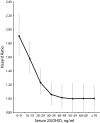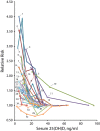Meta-analysis of all-cause mortality according to serum 25-hydroxyvitamin D
- PMID: 24922127
- PMCID: PMC4103214
- DOI: 10.2105/AJPH.2014.302034
Meta-analysis of all-cause mortality according to serum 25-hydroxyvitamin D
Abstract
We examined the relationship between serum 25-hydroxyvitamin D (25[OH]D) and all-cause mortality. We searched biomedical databases for articles that assessed 2 or more categories of 25(OH)D from January 1, 1966, to January 15, 2013. We identified 32 studies and pooled the data. The hazard ratio for all-cause mortality comparing the lowest (0-9 nanograms per milliliter [ng/mL]) to the highest (> 30 ng/mL) category of 25(OH)D was 1.9 (95% confidence interval = 1.6, 2.2; P < .001). Serum 25(OH)D concentrations less than or equal to 30 ng/mL were associated with higher all-cause mortality than concentrations greater than 30 ng/mL (P < .01). Our findings agree with a National Academy of Sciences report, except the cutoff point for all-cause mortality reduction in this analysis was greater than 30 ng/mL rather than greater than 20 ng/mL.
Figures




References
-
- Lowe LC, Guy M, Mansi J et al. Plasma 25-hydroxy vitamin D concentrations, vitamin D receptor genotype and breast cancer risk in a UK Caucasian population. Eur J Cancer. 2005;41(8):1164–1169. - PubMed
-
- Bertone-Johnson ER, Chen W, Holick MF et al. Plasma 25-hydroxyvitamin D and 1,25-dihydroxyvitamin D and risk of breast cancer. Cancer Epidemiol Biomarkers Prev. 2005;14(8):1991–1997. - PubMed
-
- Abbas S, Linseisen J, Slanger T et al. Serum 25-hydroxyvitamin D and risk of post-menopausal breast cancer—results of a large case–control study. Carcinogenesis. 2008;29(1):93–99. - PubMed
-
- Garland CF, Comstock GW, Garland FC, Helsing KJ, Shaw EK, Gorham ED. Serum 25-hydroxyvitamin D and colon cancer: eight-year prospective study. Lancet. 1989;2(8673):1176–1178. - PubMed
-
- Garland C, Shekelle RB, Barrett-Connor E, Criqui MH, Rossof AH, Paul O. Dietary vitamin D and calcium and risk of colorectal cancer: a 19-year prospective study in men. Lancet. 1985;1(8424):307–309. - PubMed
Publication types
MeSH terms
Substances
LinkOut - more resources
Full Text Sources
Other Literature Sources
Medical

